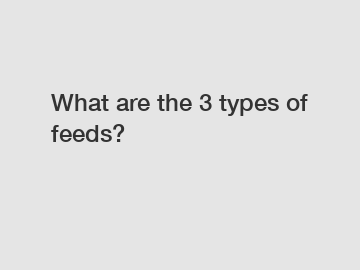What are the 3 types of feeds?
What are the 3 types of feeds?
In today's digital age, feeds play a crucial role in delivering content to users. Feeds, also known as web feeds or RSS (Really Simple Syndication), enable users to access updated content from various sources in a centralized location. They provide a convenient way for users to stay updated with news, blog posts, podcasts, and other multimedia content. Feeds can be categorized into three main types: RSS feeds, Atom feeds, and JSON feeds. Let's explore each of these types in detail.
RSS Feeds.

RSS (Rich Site Summary) feeds are one of the most widely used types of feeds. They have been around since the early 2000s and are supported by a wide range of web applications and platforms. RSS feeds contain a structured XML file that includes a list of items with titles, descriptions, and links to the full content. Users can subscribe to RSS feeds using feed readers or aggregators, which collect and display the latest updates from multiple sources in a single interface. RSS feeds are commonly used by news websites, blogs, and podcasts to distribute their content to a broader audience.
Atom Feeds.
Atom feeds are another popular type of feed, similar to RSS feeds but with some differences in their structure and functionality. Atom feeds also use XML format, but they provide more flexibility and extensibility compared to RSS feeds. Developed as a standardized alternative to RSS, Atom feeds allow for easier integration with web services and provide additional features such as author attribution and publishing timestamps. Many blog platforms, content management systems, and podcasting platforms support Atom feeds alongside or instead of RSS feeds.
JSON Feeds.
JSON (JavaScript Object Notation) feeds are a newer type of feed that have gained popularity in recent years. Unlike RSS and Atom feeds, which use XML, JSON feeds utilize the JSON data format, which is widely used for web APIs and data exchange. JSON feeds offer a more modern and lightweight approach for content syndication. They are easier to parse and consume in applications built with JavaScript or other programming languages that natively support JSON. JSON feeds provide similar functionalities as RSS and Atom feeds, including item titles, descriptions, and links. They have become particularly popular among developers and tech-savvy users.
In conclusion, feeds have revolutionized the way we consume and distribute content on the internet. With the rise of RSS, Atom, and JSON feeds, users have a wide range of options to choose from when it comes to staying updated with their favorite sources. Whether it is news, blog posts, podcasts, or other forms of multimedia content, feeds provide a convenient way to access it all in one place.
If you have any questions or would like to learn more about feeds, please don't hesitate to contact us. We are here to assist you and provide further information on how feeds can benefit your digital experience.
If you want to learn more, please visit our website pelleting aids for animal feed, pellet coater, feed pellet machine conditioner.
209
0
0

Comments
All Comments (0)